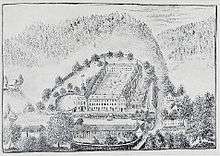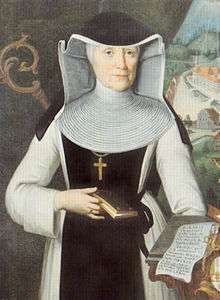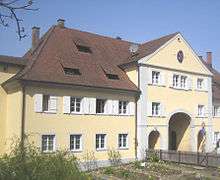Günterstal Convent
The Günterstal Convent was a Cistercian convent that existed from 1221 to 1806 located in Günterstal, which today is a district in Freiburg im Breisgau, Germany.

History
The first documented mention of the Günterstal Convent dates back to September 15. 1224, when Konrad II von Tegerfelden, Archbishop of Constance, inaugurated a new altar in the chapel of the yet unfinished convent. In later writings, the convent writes that is founding years was 1221.[2] A nobleman of the Castle of Kybfelsen is said to have founded the convent for his daughters Adelheid and Berta. They were joined by other women who were seeking to live in a monastic community. Soon, the convent's community came into contact with Tennenbach Abbey, which was then restricted to men only. It is presumed that the admission to the Cistercian religious order took place soon after 1224. The abbot of Tennenbach was Pater Immediatus (Father Immediate) of the convent until the secularisation. As such, he supervised the convent, conducted visitations, and was responsible for the appointment of the abbess as well as her inauguration.
In 1233, Pope Gregory IX. validated the possessions of the convent.[3] In 1238 the convent changed its location to Oberried, only to be relocated back to Güntersthal six years later.[4] In 1246, Pope Innocent IV validated the convent's possessions, which had grown through gifts and donations, as well. Among the most important donations were the Günterstaler Dinghof (a courtyard) of the St. Peter monastery. It had been exchanged for a courtyard in Scherzingen. A property register from 1344 shows that the convent owned up to ninety locations including the animal pound in Mundenhof. At this time the community of Günterstal consisted of twenty-five homes. The nobility from the region, such as the Küchlin, Geben and the Schnewlin families, made frequent donations to the cloister. Their unmarried daughters who wanted to join the convent had to donate all of their possessions to it, unlike regular convents. These lay sisters would provide abbesses in Germany as well as in 'Further Austrias' estates. Abbots were selected from the local nobility that was supporting the cloister (such as the Schnewlin, Falkenstein, and Blumegg).[5]
The residents of the convent consisted of noble sisters who gave directions on the one hand and lay sisters and attendants on the other. The chaplain and the confessor were provided by the Tennenbach Monastery. The Günterstal Convent also assisted in the effort to reclaim land by clearing forests. In 1278 the need for a bigger convent became apparent. In 1279 the first abbess Adelheid († 1281) resigned from her position.
In 1486, the convent was damaged by a flood. During war-times, it was repeatedly plundered. During the Peasants' War in May 1525, Abbess Agnes of Tußlingen, fled to Freiburg where she later died. The convent was plundered and later claimed an indemnity of 2218 gulden.[6] In 1932, the lay sisters managed to escape the Swedish army by fleeing to Rheinau Abbey.

In 1674, the cloister discharged Abbess Agnes of Greith and her subordinates of their peonage. After improving the financial situation of the cloister in 1727, Abbess Maria Rosa of Neveu decided to replace the old convent building with a new one. Between the timespan of 1728 to 1748 under Abbess Maria Franziska Cajetanna of Zurthannen, the new convent building was constructed according to Peter Thumb's baroque design.
Secularisation
The convent managed to overcome the Josephinian reform. After the electorate of Baden had declared any monasteries and convents abolished on January 30, 1806, on February 3rd Günterstal Convent was formally seized.[7] The abbess and sisters received pensions from the state and left the convent before October 25. The last sister of the convent died in 1843.
The abbess
The last abbess was Maria Francisca von Thurn und Valsassina from 1770 to 1806.
| Name | Personal data | Terms | Annotation |
|---|---|---|---|
| Adelheid (von Horben ?) | ? - 1281 | 1224 - 1279 | |
| Adelheidis | 1285 | ||
| Heintrudis von Müllheim | 1287 - 1291 | 1293 an altar is consecrated | |
| Gutun | 1292 - ? | ||
| Anna Lapp | 1297 - ? | originates from Freiburg nobility | |
| Adelheid von Munzingen | 1305 - ? | ||
| Anna Lapp | 1311 - 1324 | second term | |
| Agnes Tegenhard | 1325 - ? | ||
| Elisabeth von Schlettstadt | 1329/1330 | ||
| Katharina Schwab | 1333 | ||
| Mechthild Opfinger | 1334 - 1348 | ||
| Katharina Morser | 1357 - 1359 | ||
| Mechthild Opfinger | 1360 - 1366 | second term | |
| Katharina Morser | † 1373 | 1366 - 1373 | |
| Elisabeth | 1376 - 1388 | causes the abbot of Tennenbach to lose his function as senior abbot. | |
| Anna Meiger | † 1418 | 1401 - 1412 | |
| Klara von Hornberg | † 1418 | 1401 - 1412 | |
| Margarethe Brenner | 1431 - 1464 | the cloister is getting anathematized, anathema revoked 1435 | |
| Verena Tegelin von Wangen | † 1490 | 1457 - 1480 | |
| Mechthild von Falkenstein | † 1482 | 1480 - 1482 | |
| Agnes von Tußlingen | 1482 - 1504 | 1482 the cloister inhabits 29 sisters and 3 lay sisters. | |
| Veronica von Müllheim | † 1508 | 1504 - 1508 | |
| Agnes von Tußlingen | † 1525 | 1508 - 1525 | second term; flees to Freiburg during the German Peasants' war, where she deceases and is buried. |
| Kunigund Roeder von Diersburg | † 1530 | 1525 - 1530 | |
| Maria Schnewlin von Bollschweil | 1530 - 1534 | ||
| Verena Tegelin von Wangen II | † 1551 | 1534 - 1540 | resigns after dispute with the convent |
| Maria von Roggenbach | † | 1540 - | |
| Maria Schnewlin von Bollschweil | 1530 - 1534 | ||
| Maria Agnes von Greuth | ? - 1694 | 1669 - 1694 | the convent has 14 sisters, 2 Neophytes and 5 lay sisters |
| Maria Francisca von Grammont | 1668 - 1716 | 1696 - 1716 | |
| Maria Rosa von Neveu | ? - 1728 | 1716 - 1728 | started building a new church in 1728 with the help of master-builder Peter Thumb |
| Maria Francisca Cajetana von Zurthannen | 1695 - 1770 | 1728 - 1770 | issued the construction of the baroque church complex |
| Maria Francisca von Thurn und Valsassina | 1740 - 1808 | 1770 - 1806 | in 1780, the cloister inhabits 19 sisters and 10 lay sisters; in 1806 there were only 6 sisters and 5 lay sisters left beside the abbess |
After secularisation
The company Friedrich Mez & Comp., which was founded on 1 June 1812, bought the cloister building along with the surrounding buildings and the plot of land, for 8000 Gulden on the 5th of September 1812.[8] They constructed a cotton mill, which had to be auctioned off soon after in 1817. The new owners, Benedict and Marquard von Hermann then hired mainly children from the ages of 12-14 to work at the mill. In the night between the 3rd and 4 April 1829, the mill was burnt almost completely to the ground. There were rumours that the fire had been caused by arson, maybe even by the owner himself.[9] A reward was offered for any information relating to the crime.[10][11][12]
The south and west wings of the former cloister building were completely destroyed, and the other two wings were burnt up to the first floor. These two wings were reconstructed again. However, the cotton mill was replaced by a brewery. In a neighbouring building, a weaving mill was being run. After the death of the owner in 1840, his widow sold the brewery to Gustav Schelte. The weaving mill was continued to be operated on by the family of von Hermann. In 1859 other shareholders were added, who lead the enterprise under the company name Mechanische Baumwoll-Weberei Güntersthal until it was completely taken over by a Swiss shareholder named Gottlieb Siebenmann. The brewery had already been purchased in the name of the Catholic Orphanage Foundation in 1892 by Mathäus Jungmaier, who had constructed an orphanage there.[13] In 1896 the foundation headed by Siebermann also purchased the old cloister building. Today, there is a French-German boarding school,[14] a kindergarten, and a social institution in the two renovated wings.
The Church of Our Lady
The church (today called The Church of Our Lady), which was also destroyed in the fire of 1829, was rebuilt by the state in 1833/34 after the plans of Gottlieb Lumpp, who used the outside walls to help reconstruct the church. It was finally, renovated in the years 1998 to 2002. Efforts were made to keep as much as possible of the original interior design.[15] Today, the church is being used by the catholic pastoral care Freiburg Wiehre-Günterstal.[16]
References

- ↑ Franz Josef Gemmert: «Die Schicksale der Textilfabriken in den säkularisierten Breisgauer Klöstern». In: Schau-ins-Land, Bd. 77 (1959), p. 77
- ↑ Suso, Frank S. 1
- ↑ s. Bader S.138
- ↑ s. Bader S. 140
- ↑ s. Bader S. 141
- ↑ s. Karl Seith : Das Markgräferland und die Markgräfler im Bauernkrieg des Jahres 1525. Karlsruhe 1926, S. 61 und 97
- ↑ s- Dreher Äbtissinnen S. 47
- ↑ im Inventar vom Juni 1806 war diese Liegenschaft mit 30 000 Gulden angesetzt worden
- ↑ s. Dreher 1997, S. 260/261
- ↑ s. Freiburger Zeitung Nr. 99, S. 493 vom 9. April 1829 online bei der UB Freiburg
- ↑ s. Freiburger Zeitung Nr. 112, S. 562 vom 22. April 1829 online bei der UB Freiburg
- ↑ s. Freiburger Zeitung Nr. 115, S. 578 vom 25. April 1829 online bei der UB Freiburg
- ↑ s. Gemmert S. 82
- ↑ s. Homepage des Gymnasiums
- ↑ s. Suso Frank, S. 28
- ↑ s. Homepage der Seelsorgeeinheit
Bibliography
- Josef Bader: Die Schicksale des ehemaligen Frauenstifts Güntersthal bei Freiburg i. Br. In: Freiburger Diözesan Archiv Band 5 (1870) S. 119-206 online bei UB Freiburg
- Ernst Dreher: Das Kloster Günterstal: von d. Wahl d. letzten Äbtissin (1770) bis zur Franz. Revolution (1789). In: Schau-ins-Land, Bd. 108 (1989), S. 169-194 online bei UB Freiburg
- Ernst Dreher: Die Äbtissinnen des Zisterzienserinnenklosters Günterstal. In: Freiburger Diözesan Archiv Band 120 (2000) S. 5-51 online bei UB Freiburg
- Ernst Dreher: Kirche, Kloster und Kapellen in Günterstal. In: Schau-ins-Land, Bd. 106 (1987), S. 31-68 online bei UB Freiburg
- Ernst Dreher: Anmerkungen zur Gründungsgeschichte der Zisterzienserinnenklöster Wonnental und Günterstal. In: Schau-ins-Land, Bd. 110 (1991), S. 109-118 online bei UB Freiburg
- Ernst Dreher: Günterstal im Jahre 1795. In: Schau-ins-Land, Bd. 112 (1993), S. 105-134 online bei UB Freiburg
- Ernst Dreher: Die Gemeinde Günterstal zwischen 1806 und 1830, In: Schau-ins-Land, Bd. 114 (1995), S. 135-161 online bei UB Freiburg
- Ernst Dreher: Die Gemeinde Günterstal von 1806 bis 1830 (2. Teil). In: Schau-ins-Land, Bd. 116 (1997), S. 253-281 online bei UB Freiburg
- Karl Suso Frank: Kath. Pfarrkirche Liebfrauen Freiburg-Günterstal, Kunstverlag Josef Fink, Lichtenberg, 2005, ISBN 3-89870-231-6
- Franz Josef Gemmert: Die Schicksale der Textilfabriken in den säkularisierten Breisgauer Klöstern. In: Schau-ins-Land, Bd. 77 (1959), S. 62-89, Günterstal S. 76-82 online bei UB Freiburg
- Constanze Kienast: Sei im Besitze und du wohnst im Recht. Der Günterstaler Berain von 1344: ein typischer Vertreter mittelalterlicher Güterverzeichnisse?. In: Schau-ins-Land, Bd. 112 (1993), S. 31-48 online bei UB Freiburg
- Albert Krieger, Badische Historische Kommission [Hrsg.]: Topographisches Wörterbuch des Großherzogtums Baden, Band 1, Spalte 792-797 Heidelberg, 1904 online bei der UB Heidelberg
- Fritz Ziegler: Wappenskulpturen des Klosters Günterstal. In: Schau-ins-Land, Bd. 51-53 (1926), S. 88-92 online bei UB Freiburg
External links
| Wikisource has original text related to this article: |
| Wikisource has original text related to this article: |
![]() Media related to Zisterzienserinnenabtei Günterstal at Wikimedia Commons
Media related to Zisterzienserinnenabtei Günterstal at Wikimedia Commons
- Fridrich Pfaff: Der Günterstaler Palmesel. In: Alemannia. Zeitschrift für alemannische und fränkische Geschichte, Volkskunde, Kunst und Sprache. Vol. 39, Freiburg im Breisgau bei Friedrich Ernst Fehsenfeld, 1911, p. 160 (in German)
- "Kloster Günterstal", badische-seiten.de, retrieved 25 March 2014 (in German)
- "Liebfrauenkirche Günterstal", badische-seiten.de, retrieved 26 March 2014 (in German)
- "Historische Gebäude - ehem. Zisterzienserinnenkloster", Stiftungsverwaltung Freiburg, retrieved 25 March 2014 (in German)
Coordinates: 47°57′59″N 7°51′39″E / 47.9664°N 7.8608°E